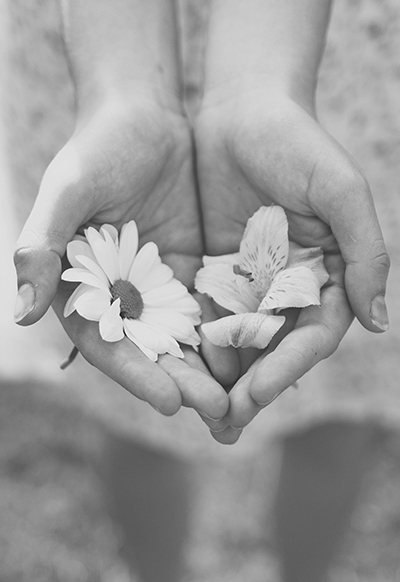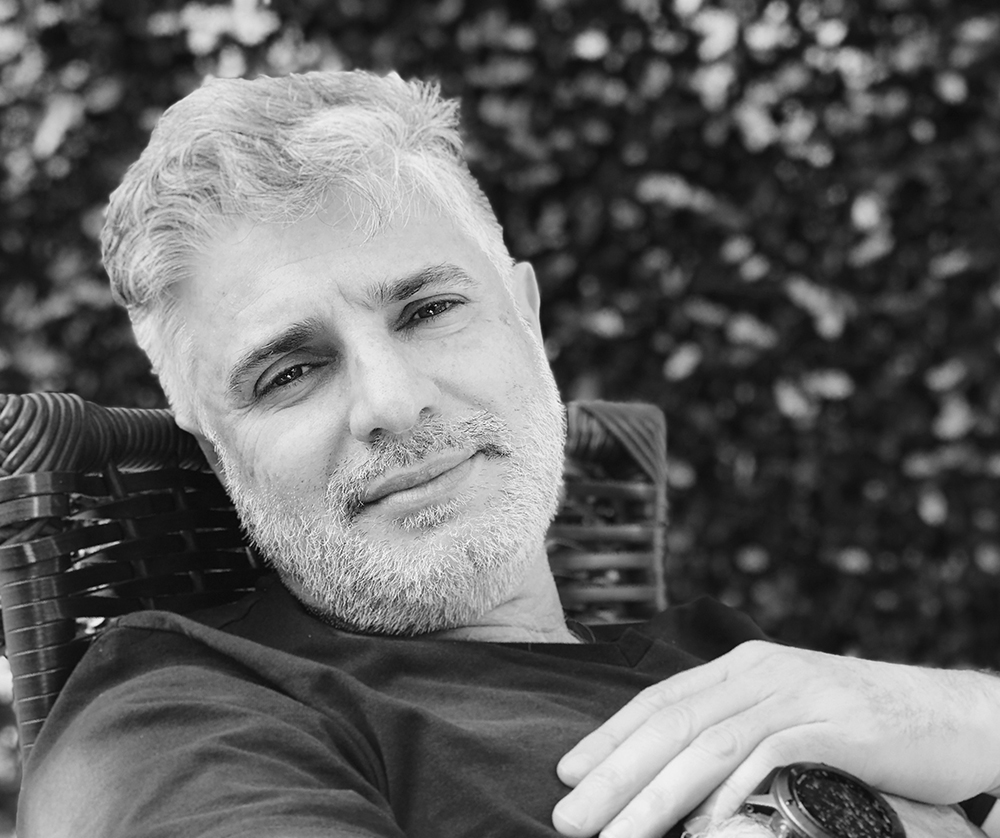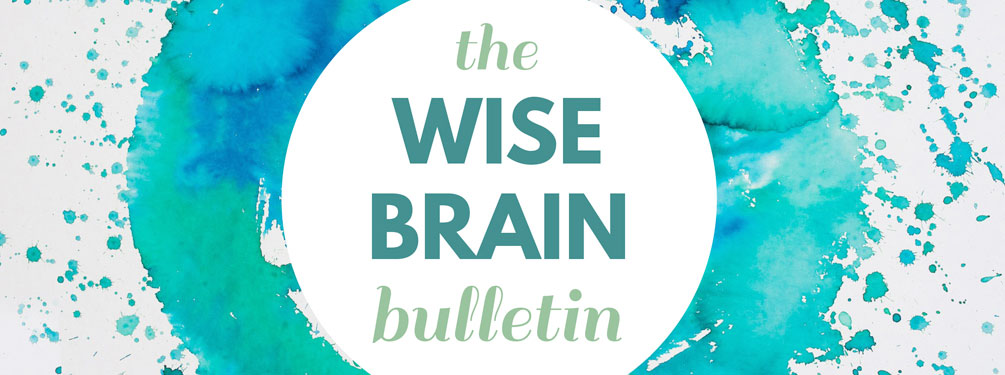News and Tools for
Happiness, Love, and Wisdom
volume 12.3 • 2018
In This Issue
Searching for Kindness
© 2018 Tara Cousineau, PhD
Adapted from The Kindness Cure: How the Science of Compassion Can Heal Your Heart and Your World. Reprinted with permission from New Harbinger Publications, Inc.
“Mom, I have something to tell you. But I want you to hear me out before you say anything.” When a seventeen year old daughter starts a conversation like this, what parent doesn’t brace for the worst? Car crash. Date rape. Pregnancy. I held my breath. Sophie explained that the night before she had been physically attacked by another girl. My daughter showed me the deep nail marks across her chest and back. I flinched. Her boyfriend had taken a photo of Sophie’s bloodied nose, which I refused to look at because I didn’t want the image imprinted in my brain.
“Are you okay now?” I pleaded.
“Yes.”
“Are you afraid something else might happen?”
“Not really.”
“Why did this girl jump you?”
“An old grudge... Jealously... A power trip.”
My impulse was to bang down the door of the girl’s house and ream out her mother. But Sophie took the high road: she showed compassion for the girl and her life situation - much more grace than I could muster. As a clinical psychologist working primarily with girls and women for two decades, I know a lot about mean girls. Sophie didn’t expect an apology, and the girl never offered one. It all fell into the past. But the skirmish really stuck in my craw. It was so unkind.

The incident inspired me to dig deep, to draw on my own practices of mindfulness and compassion in the face of meanness. But given the state of our world during the contentious 2016 U.S. presidential election, this felt hard to do. Political mudslinging had intensified. Children had started becoming anxious or aggressive, openly taunting immigrants and disabled people. Bullying was on the rise and so were fears of deportation. Swastikas were painted in our local middle school, and our Holocaust memorial was desecrated. Many of us felt horrified by the discourse on the treatment of women and girls. Moreover, a steady stream of atrocities amplified fears that the world is dangerous: the refugee crisis, terrorist attacks seemingly everywhere, public mass shootings, young black men continually killed by police officers, rioting, acts of retaliation. Instead of responding with unity or cohesion, all this created more divisiveness and separation among us.
Greetings
The Wise Brain Bulletin offers skillful means from brain science and contemplative practice – to nurture your brain for the benefit of yourself and everyone you touch.
The Bulletin is offered freely, and you are welcome to share it with others. Past issues are posted at http://www.wisebrain.org/tools/wise-brain-bulletin.
Rick Hanson, PhD, edits the Bulletin. Michelle Keane is its managing editor, and it’s designed and laid out by the design team at Content Strategy Online.
To subscribe, go to http://www.wisebrain.org/tools/wise-brain-bulletin.
And yet, I resonated with Selena Gomez’s song, “Kill ’Em with Kindness,” that my girls were listening to. It was timely, and it kept me going. The topic of kindness became central to the many conversations I was having at home, among colleagues, and with clients. The question kept popping up, over and over: What happened to kindness? The world felt like a meaner place, even though historians insist that we live with less violence and more democracy. Everything seemed to be breaking into pieces, and empathy, respect, and common decency became dwindling resources.
Because it can, quite simply, feel too hard to be generous in spirit within such an environment. But as I learned, it does feel easier when you understand the power you are wielding when you are kind. When facing anything that feels threatening - be it political, personal, or as natural as a life change - you can “kill” your fears with kindness.
I started inviting people to share reflections and stories on kindness. I’d ask, “Do you consider yourself a kind person? How so?” Either people had a quick reaction: “Oh, trust me, I’m not a kind person.” Or they were stumped: “Gosh, I really have to think about that one.” Mind you, plenty of people came up with kindness stories: a person giving up an airplane seat for a pregnant woman after her flight was canceled; a cabbie lending money to someone with a lost wallet; an unexpected thank-you card; daffodils left on doorsteps. But half the time, people had to stop and think for a while about kindness. It became clear that, in general, we are grappling with it - as if kindness is hiding in a corner and we have to search it out to find it.
A Fear of Kindness
We seem to have a kindness phobia on our hands. People are afraid to be kind, to admit to being kind, to trust people who are kind, to pay attention when kindness does happen. What’s going on? Has our speedy technological world made it too easy to disengage from one another, fetishize our differences, and normalize a cool-to-be-cruel mentality? Does the world feel so unsafe that we are being overprotective? If so, are we reverting to a survival mentality that reserves kindness for our children, close family, and friends? Have we prioritized values like personal success and happiness over the well-being of others to the extent that the Golden Rule is a relic of the past? Are we expecting people to be kind but don’t enact it ourselves? Or do we simply take everyday kindness for granted?
Answer: all of the above. These questions are recycled in history, and different ages have different results. “Kindness is always hazardous because it is based on a susceptibility to others, a capacity to identify with their pleasures and sufferings,” write psychoanalyst Adam Phillips and historian Barbara Taylor. Their brief historical account on the rise and fall of kindness laments its decline as the Victorians conceived of it, which was an openheartedness that linked people to one another. There was a sense that our lives depended on being kind because, as philosopher Jean-Jacques Rousseau wrote, “Our sweetest existence is relative and collective, and our true self is not entirely within us.” Kindness included expanding beyond people within an inner circle to view strangers as kin, which cultivated the Victorian recognition of a shared humanity. This was uplifting and motivational. It led to caring cultures.
The attitudes of modern society - with emphasis on self-sufficiency, self-interest, and separation - have eroded our confidence in kindness as an orientation to living a meaningful life and as a civic virtue. Kindness has become associated with being weak, fragile, feminine, nostalgic, and untrustworthy. Yet our instinct for kindness percolates to the surface all the time, because our basic neurology is wired to care. As Taylor and Phillips write, it’s a paradox: “People are leading secretly kind lives all the time but without a language in which to express this, or cultural support for it.”

Bothering to Care
This fear is made vivid by the Making Caring Common project at Harvard’s Graduate School of Education. The executive director, Rick Weissbourd, observes that we are in an era of high-achievement pressure and that we emphasize individual happiness. “What we don’t see is more focus on concern for others, concern for community.” Weissbourd believes, and I agree, that we need more caring opportunities and demonstrations of kindness, especially among people different from us.
The project’s report, titled The Children We Need to Raise, surveyed more than ten thousand diverse youth. Almost 80 percent of the youth picked “high achievement” or “happiness” as their top value, while roughly 20 percent selected “caring for others.” The general findings were that “young people neither prioritize caring for others nor see the key people around them as prioritizing it.” The researchers observed a gap between caring rhetoric and reality, between what parents and other adults say are their top priorities and values and the messages they convey by daily behavior: when children do not prioritize caring and fairness in relation to their self-concerns - and when they view their peers as even less likely to prioritize these values - there is a lower bar for many forms of harmful behavior, including cruelty, disrespect, dishonesty, and cheating.
The report cautions us about the misguided values and behaviors of today’s children, and it implicates the society in which they are raised. It implicates us. We can see the gap between rhetoric and reality almost everywhere we look: politics, business, education, parenting. If we value caring and kindness, then we need to cultivate it in ourselves, in our relationships, and in our community. Weissbourd reflects: “I think the good news is that lots of kids do value caring and kindness. Just too often they are valuing it second [to happiness and achievement].”
Empathy Overload
A month after my daughter, Sophie, got punched in the nose, I had the opportunity to speak with “the happiest man in the world,” Matthieu Ricard, a cherished Buddhist monk, humanitarian, and meditation researcher. I asked him mundane questions about empathy, especially how to help people who feel too much empathy.
It was a bit of a family curse, I admitted.
“Be glad,” he said.
I lamented that it can be exhausting.
“Yes,” Ricard replied, “but you start with just one thing, close to home, and that is okay. Better to start with too much empathy than too little,” he assured me.
That same week, I visited the U.S. Holocaust Memorial Museum - effectively expanding my exploration of empathy from mundane to vastly cultural. My mother emigrated to the United States from Germany. She was born in 1938, a poor Catholic girl whose earliest memories were of bomb shelters and near starvation. As a child, my mother had no understanding of the world instilling in her children an intense sense of obligation, of the self-sacrificing variety, to help others. Like me, my daughters inherited this emotional legacy.

At the memorial museum, I became fixated on a display containing children’s books, toys, and posters - all intended to indoctrinate children into militarism, racism, and anti-Semitism. Now anything having to do with the Jewish Holocaust brings me to my knees. And I’m not naive to the repetitions in recent history. But the children’s books triggered me that day. I reflected on the vast capacity of the human imagination and began wondering whether - if we can mastermind the spread of cruelty - we can mastermind the spread of kindness instead.
My questions about kindness began to shift, from how hard it feels to how we can grow and sustain kindness. With all that is being hailed these days about neuroplasticity - the ability of our minds to be shaped by experience, and the ability to shape our minds with experience - it occurred to me that we can lay down neural networks for kindness. We can engage systematic practices that cultivate feelings of compassion and communities of caring.
Matthieu Ricard describes kindness as a mode of altruism, a form of caring and warmhearted consideration that is manifested in how you behave toward others. For Ricard, your natural empathic concern for others can be a catalyst for kindness and compassion, and this can be expanded through various meditative practices and skills. Empathy is a basic connecting point with others that can be experienced on a continuum: it can cause you to be flooded with distress, or you can harness it into kindness. This is a skill of motivational empathy - the ability to put yourself in another’s shoes and also not get too lost in heightened emotional states that can lead to disempowerment. The key point here is that you can use empathy to intentionally expand your awareness of and capacity for kindness.
What Is Kindness?
Kindness is love in action. So, let’s first look at love. Your love can be the result of a lasting bond, like you have with friends and family. It can also be expressed for any living or nonliving thing, springing forth at any moment in time. Love is the mother of all uplifting emotions and embraces all other positive emotions - amusement, compassion, gratitude, joy, pride, serenity, and so on - under her care that enrich your life and that of others for the better. Kindness is the conduit for the vastness of love’s expression. It is any act of love that reflects genuine caring. Such kindfulness is the embodiment of your feelings of warmth and generosity toward others and the world at large - and your desire to bring relief to those who are suffering. In this way, kindness is both a quality of loving presence and an orientation to life that is intentional and active. This is a message offered by spiritual masters, mystics, and poets: love and kindness are within you, they connect all of us, and they’re also larger than us. When such limitless loving-kindness is practiced, your relationships with yourself and others lead to authentic happiness and well-being.
It is an antidote to fear. Sharon Salzberg teaches how this works: a mind filled with fear can be penetrated and conquered by loving-kindness, and a mind that is infused with loving-kindness cannot be overcome by fear.
This kind of unconditional love toward yourself and others is called mettā in Buddhist texts. “Mettā - the sense of love that is not bound to desire, that does not have to pretend that things are other than they are - overcomes the illusion of separateness, of not being part of a whole.” This type of loving is an expression of kind acceptance. Rather than pushing away difficult feelings or reacting aggressively to change something or someone or the world itself, you can experience a profound happiness that does not depend on external conditions. But the world is constantly testing us, isn’t it?

Tender Love and Care
When the anniversary of the September 11 attacks fell on a Sunday, I was looking for solace and community. So I decided to go to church. It was a blustery and humid day, with rain splattering against the tall windows. It felt cozy and peaceful. Ahh, I thought, the world is quiet here.
In the middle of the service, the minister’s microphone turned off. Alerted to this, she reached for her device and flicked the switch. Boom! The acoustic shudder tore through the church and everyone jumped in unison, hands to ears. We were shocked into silence. It hurt.
Then the lone wail of a little girl filled the hall. Gathering herself, the minister walked off the sanctuary stage and up the aisle toward the crying four-year-old, who was clinging to her father’s neck.
“That was a really scary sound, wasn’t it?” the minister asked softly, speaking to the child as if she were the only person in the room. “There are other sounds that aren’t so scary. We can make them too. Should we try?” The minister began to hum softly to the child. The rest of the parishioners joined in unison. The girl’s sobbing faded into song.
 That morning, two things stood out for me: the utter stillness needed to recover from the assault of the noise and the compassionate attention offered to the crying child. How nice if we all could be comforted in such distressing moments - by others or by our own ability to self-soothe. Because every single day you, like me, experience noise and distractions from the outside. It may not be a piercing boom but rather a steady stream of demands on your attention that’s part of living in this modern world: to-do lists, texts, news, social media, job tasks, family needs, bills, rush-hour traffic. These can pile up until you feel bombarded and scattered.
That morning, two things stood out for me: the utter stillness needed to recover from the assault of the noise and the compassionate attention offered to the crying child. How nice if we all could be comforted in such distressing moments - by others or by our own ability to self-soothe. Because every single day you, like me, experience noise and distractions from the outside. It may not be a piercing boom but rather a steady stream of demands on your attention that’s part of living in this modern world: to-do lists, texts, news, social media, job tasks, family needs, bills, rush-hour traffic. These can pile up until you feel bombarded and scattered.
You might also experience distractions inside yourself that come as unhelpful beliefs, complaints, rehashes of past disappointments, or wishes for a brighter future because what you have now is lacking somehow. It’s so easy to be unkind, berating yourself internally with thoughts like “I have no time for anything that matters,” “It’s my rotten luck,” or even “What’s wrong with me?”
Both external and internal assaults can keep you in a constant state of stress that can lead to serious harm in your emotional states, health, and relationships. Just as the little girl in the church needed to be tended to after a jolt to her senses, as an adult you do too. Self-soothing is a foundation for emotional self-regulation, and it arises from a very basic need - to be comforted with generous doses of TLC.
Face-to-Heart Interactions
“Compassion for others begins with kindness to ourselves,” says the meditation teacher Pema Chödrön. Many wise people insist that in order to love others, we must first love ourselves. Paradoxically, self-kindness doesn’t just spring out of nowhere - it arises from being physically held by another person from the moment you were born. Envision the quintessential image of a mother with babe in arms, perhaps a memory of holding your own infant. Physiologically, a bonding process is unfolding within that image - eye gazing, rhythmic breathing, beating hearts, cooing sounds - sealing the human connection. Such tenderness is inherently social and has been part of your neurobiology from the start of your life.
The Wellspring Institute For Neuroscience and Contemplative Wisdom
The Institute is a 501c3 non-profit corporation, and it publishes the Wise Brain Bulletin. The Wellspring Institute gathers, organizes, and freely offers information and methods – supported by brain science and the contemplative disciplines – for greater happiness, love, effectiveness, and wisdom. For more information about the Institute, please go to http://www.wisebrain.org/wellspring-institute.
If you enjoy receiving the Wise Brain Bulletin, please consider making a tax-deductible donation to the Wellspring Institute. Simply visit WiseBrain.org and click on the Donate button. We thank you
Stephen Porges developed a theory about what he calls our “social nervous system” and our ability to get calm. It’s called polyvagal theory, which refers to the two vagus nerves that begin the brain stem. The vagus nerve, the longest nerve in the body with the widest reach, is like a vine that branches throughout your body. It connects the brain with the heart and runs through the throat and neck, and into the gut. It supports the parasympathetic nervous system. One branch of the vagus nerve evolved later and is unique to mammals who need other mammals for survival - yes, humans need each other. This newer nerve branch is involved in your body’s ability to self-regulate, connect, and communicate with others. It’s also involved in your intuitive abilities or “gut instinct.”
This nerve branch allows your nervous system to unconsciously detect safety and risk in your environment, which Porges calls neuroception. It’s your body’s way of asking: “Is this person I’m with safe?” “Is it okay to approach him or her?” “Should I be in this situation or should I leave?” The body responds first, the mind later. So when your body automatically responds to stress, it might happen in ways you can’t understand, such as fighting, running, or freezing. Sometimes you may feel ashamed about your reaction later: “Why didn’t I speak up?” “Why didn’t I run?” “I went totally blank.” “Why didn’t I say hello?” “What’s wrong with me?” The stories you tell yourself afterward - fraught with regret, shame, or blame - can hinder understanding and healing.

Awareness of how your body is responding to something is important because it allows you to understand your triggers, and when you have this understanding you won’t feel at such odds with yourself. This is the root of self-care. You can even consciously engage the vagal system for soothing. One way is to use your voice. You can speak to anyone, even yourself, in a lulling, affectionate tone, which is called “motherese” or “vocal prosody.” That has a profound calming effect physiologically. Like the frightened little girl in the church, you can quickly feel soothed by a gentle tone, whether you’re making it aloud or silently in your mind. These kinds of “face-to-heart” interactions are the seeds of emotional self-regulation. So even when you don’t have people you love and trust at your side when you need them, you can recruit your own physiology to nurture yourself. All it takes is a bit of gentle self-talk.
People with strong vagal tone - a measurement of heart rate variability and stress hormones - tend to be good at calming down and bouncing back from stress, and they report a higher quality of life. And various experiments show that compassionate responses activate the vagal nerve and promote well-being. So be well, tend to yourself, and kindness will flourish.
Kindness in Practice:
Self-Compassion Statements
To consciously engage your vagal system for self-soothing, start by creating your own compassion statements. Psychologists Christopher Germer and Kristin Neff offer an exercise that can train your brain to be more loving. You can create messages of kindness to meditate on and repeat, which calms your body and nurtures goodwill toward yourself. The instructions for creating these personal affirmations are simple:
- Be clear,
- Be authentic and true to your experience, and
- Use a kind tone.
Whenever you need bolstering, you can craft a message by asking yourself, “What do I need to feel calm in my body?” or “What do I yearn for from others?” The answers are typically universal human needs: belonging, connection, encouragement, love, patience, protection, respect, tolerance, validation, well-being. For example, while writing this book, creating personal statements helped me assuage self-doubt and anxiety. One statement I wrote was “I have a beautiful message to share with the world. I will speak my truth.” When you land on the right phrase, in response you’ll sense a twinge of relief, a spark of inspiration, or gratitude: “Ah, this fits for me,” “Oh, this feels right,” or “Thank you.” You can also try one of these on for size and refine it as you go, and switch “I” for “you” depending on how you like to hear your inner voice.
I love myself just as I am.
I will be okay.
I trust in myself.
I hold myself gently.
I’ve got this.
I am here for me, I am here for you.
I am strong.
I am beginning to feel love and kindness expand.
Even though this feels hard, I will be gentle with myself.
You have the ability to influence how you respond to life’s struggles. “Compassion isn’t some kind of self-improvement project or ideal that we’re trying to live up to,” Pema Chödrön writes. “Having compassion starts and ends with having compassion for all those unwanted parts of ourselves, all those imperfections that we don’t even want to look at.” Drawing upon your inner resources for caring, you can quiet your brain’s alarm system, build resilience, and feel a greater sense of empowerment. Porges says, “What we really need to do is inform ourselves about the disruptive things that may have happened to us - not to be angry or to blame but to try to understand the strategies that our body has taken to adapt and to survive. Then we can evaluate whether those are really good strategies.” The more you practice kindness for yourself, the more resilient - and compassionate - you become for others.
Reimagining Kindness
Most of us value kindness and have the desire to express it. Doing so inherently takes courage, since we must be willing to experience the vulnerability of connecting with other people - especially those who are different from us. We do have what it takes: it’s entirely natural to be relational. Quite simply, we are wired for it and we benefit from it. Studies repeatedly show positive effects of kindness on personal and collective well-being in areas as diverse as physical health, emotional health, relationships, life satisfaction, communities, and even economies. The science confirms ancient wisdom, and the data is piling in. Here are some of the things we’re learning that kindness can do:
- Activate emotional regulation and compassion networks in the brain
- Alleviate symptoms related to depression and post- traumatic stress disorder in veterans
- Protect against compassion fatigue in helping professionals and first responders
- Lessen migraines and symptoms of chronic pain
- Promote positive attitudes and compassion toward oneself and others
- Lessen judgment and increase empathy for stigmatized social groups
- Improve body image
- Strengthen romantic relationships
- Improve symptoms related to depression, anxiety, and social isolation in teenagers
- Foster stress resilience and prosocial behaviors in young children
- Promote longevity in those who volunteer

Kindness, it turns out, is a happiness fix. And you have the wiring and the natural motivation to grow kindness from the inside out. You can strengthen your instinct for compassion and encourage it in others, because when you intentionally practice it, kindness radiates from you. It spreads. It is contagious.
When tragedy or heartache strikes, often all we can do is offer kindness. But when the little, daily uncertainties and fears arise, it can feel too hard to be kind and compassionate. Likewise, when our best intentions and kind actions are met with cruelty and contempt, we can feel defeated. It is precisely in these moments when training in kindfulness is the call to action. This requires reimagining our relationship to kindness. It’s orienting yourself to a way of being that is caring, compassionate, and connected - and ultimately liberating. A protest slogan reads: “Feel the Rage, Be the Love.” These six small words perfectly capture both the challenge and the solution when facing difficult persons, places, or things. The meditation teacher Sharon Salzberg asks, “Why can’t we both love and resist at the same time?” This is a perfect question for our life and our times, and it forms the basis for reimagining kindness.
ABOUT THE AUTHOR

Tara Cousineau, PhD, is a clinical psychologist, meditation teacher, well-being researcher, and social entrepreneur. She has received numerous grants from the National Institutes of Health Small Business Innovative Research program. Cousineau founded www.bodimojo.com, and develops digital wellness tools for youth. She is affiliated with the Center for Mindfulness and Compassion at Cambridge Health Alliance in Somerville, MA, serves as a scientific advisor to www.kindness.org, and is dedicated to global efforts to spread kindness in both small ways and large. https://www.taracousineau.com/.
Say Yes (Breaking Out)
© 2017 Chris Fox
Say yes, to something you really like!
Say yes, and accept something you don’t like; (how’s them apples?)
Say yes, & accept everything, that’s happened:
Yes, I was hurt as a teenager;
Yes, I made that choice and left home so fast;
Yes, the Army soon owned me, and shaped me;
Yes, those were my attitudes as a young man;
Yes, I befriended one who influenced so much;
Yes, he created immense destruction;
Yes, I made many poor choices;
Yes, I’ve felt the humiliation & destruction of a ‘toxic boss’;
Yes, I was shattered again;
Yes I got up, again and again;
Yes, I’ve forgiven myself and others;
Yes, I have done some great things,
Yes, I have done my best;
Yes, I’m OK now!
Yes, there is always reason for hope;
Imagine life is whispering ‘Yes’;
Say yes, many, different ways;
Yes
Writer’s note: The writing of this poem was a cathartic experience for me.
It refers initially to acknowledging things you like and are happy about, and how they make you feel.
However, it’s also about acknowledging things you’re not so happy about: things you can’t change; negative things that have happened; choices you have made, their consequences; and the inevitability of life's choices.
It’s about knowing you can’t change the past; but how you deal with that, and looking ahead to the future with optimism, hope, and peace.
ABOUT THE AUTHOR

Chris Fox left his hometown of Berkeley (NSW Australia) as soon as he was old enough to join the army (with Mum's permission!). He found his way after these very formative years as: a barman, a motor vehicle production line worker, lawn mowing and gardening contractor, Mr. Mum, university student, and teacher. Now, as a semi-retired teacher, drum tutor and BnB host, he lives in the beautiful Jervis Bay area, south of Sydney.
Meditation and Creativity
© 2018 Vanessa Aragao
HOW CAN MEDITATION AND SELF-KNOWLEDGE FACILITATE CREATIVITY?
What would it be like if you could learn to operate the engine of your mind to its fullest capacity? In this article, you’ll learn to use contemplative practices, breathing exercises, and focus to steady the mind and release its vast creative potential. Through cultivating these simple practices, the mind reaches a state of calmness and fulfillment, free of tension and favoring concentration and creative thinking. A still and focused mind knows how to explore all options, free from judgment and alive with observation, curiosity, and engagement.
1: LEARN TO BREATHE
Many people want magic formulas for how to acquire these states of mind. But the basis of a still mind starts with something completely natural: the breath. Still, to temper an overactive mind, we must learn how to breathe again. That’s right. We often breathe in shallow and automatic ways that don’t utilize our full lung capacity. Breathing is our best tool for bringing us back to the present moment when we are lost in anxiety, anger and restlessness. It’s simple, immediate and always available. We just need to learn to practice it well.
Hinduism offers several exercises for cultivating breathing, called pranayamas. These exercises are associated with the four stages of the breathing process: inhaling, retention with lungs full, exhaling and retention of exhale with lungs empty. They are practiced regularly through a sequence of repetitions that helps to calm an agitated mind.
How does this work? Is it magic? Actually, we can understand how it works through a basic understanding of human physiology. When we inhale, we activate the sympathetic nervous system, which is responsible for our survival, and is expressed through the “fight or flight” response. When we exhale, the parasympathetic nervous system gets activated. This is our firefighting department, in charge of soothing us. These two systems work together like an accelerator and a brake on a car.
The problem is, in our fast-paced contemporary world, our sympathetic nervous system can be chronically activated. We’re continuously cautious, trying to detect dangers or threats, while the brain reacts by staying in alert mode 24/7. This puts us in a chronic state of anxiety that can have negative consequences for both our mind and our overall health. That’s why learning to cultivate breathing practice is so important. For example, when our exhalation is longer than our inhalation, we help to activate the parasympathetic system, which cools us off. We are then able to think more clearly and avoid actions that might hurt others and ourselves.
2: LEARN TO FOCUS
Once you lower the reactivity caused by the sympathetic nervous system through quiet breathing exercises, you are better able to access the energy inside that allows you to focus. It is not always easy to retain this relaxed state, however. When our brains are on constant alert, scanning for threats, we develop stress habits that are deeply engraved in the neural circuitry of our brains. To change the brain we must have patience and compassion.
I often tell my students to treat their minds as they would a friend. Be kind to yourself and try to gently keep your focus on your practice, without putting too much pressure on yourself. By cultivating a positive emotion – like understanding and caring for yourself – we enhance the level of dopamine in the body, which helps to focus. Focusing is about being aware and skillfully being able to manage your attention, able to direct it wherever you want and keep it there until you decide to turn it in another direction.
When attention is steady and serene, so is the mind. Fewer thoughts arise, making it easier for you to hold your focus and remain aware. Here are some helpful practices for cultivating attention:
- Start by siting in a comfortable position and begin to explore the sounds and stimuli around you. Then do the same with your inner world. Moving from the outer world to the inner world helps us to leave the usual distractions of the mind aside to focus on what is present here and now in the body.
- Focus on the physical sensations of the air coming in and going out. How does this feel in different places in your body?
- Touch your lips. Our lips have fibers that can activate the parasympathetic nervous system when touched. This can automatically bring a sense of calm into the body.
- Imagine there is a guardian in your mind who is in charge of letting you know whenever your attention starts to flag. It’s important to see this guide as kind and gentle, not fierce and authoritarian!
- Induce the language centers in your brain by counting your breaths. Begin by counting 1 to 10. Then count backwards, 10 to 1. You can engage your body in this practice by closing your hand and lifting one finger at a time to count along.
- Don’t reject your thoughts. Receive them, acknowledge them, and let them go. Try not to feed them or get pulled into them, but gently bring your attention back to your breath.
- If everything fails, turn distraction into your object of attention.
- After you finish your concentration practice, let the mind do whatever it wants. With practice, you may experience this as both weird and amusing as you realize how arbitrary and meaningless most of your thoughts are.

Visualizing can also help calm the mind. The brain spends much of its time processing the non-verbal language, so the skillful use of images can activate the emotional centers, calming inner dialogues that cause stress and captivate our attention. Images natural stimulate the parasympathetic nervous system as well. Since the brain does not differentiate between what is real from what is imagined, the effect on neurotransmitters is the same. Using images creatively and exploring them in detail helps train attention and cultivate concentration.
Remember that sleep is a very important factor in cultivating an aware mind. The brain can’t remain focused if it’s sleepy or asleep! Get as much sleep as is necessary for you and your lifestyle. Trying to be alert when you’re tired is like trying to get a worn-out horse to climb a hill.
3: COMMIT TO A MEDITATION PRACTICE
Meditation is a great way to put attention to the test. Through meditation, we hold the intention to make attention stronger. It helps to counteract the brain’s natural tendency towards survival by activating the parasympathetic nervous system. It draws our attention away from that which causes stresses, and thereby relaxes and brings great awareness to the body. Meditation practice enhances the grey matter in the hippocampus and the prefrontal cortex, improving the psychological functions associated with those areas: attention, compassion and empathy. It decreases cortisol, which is related to stress.
The secret to success is to develop a regular practice. Commit to a daily practice, even if it’s only a few minutes a day. Breaking down neural structures that have developed over a lifetime and building new ones takes dedication and time. That means you can only learn to meditate by meditating. And meditate for as long as you want to. You can set an alarm or use an incense stick or cone to track time: light it when you start; finish when it burns out.
Meditation opens an inner space for concentration to deepen. One consequence is that our mental fixations can rise more easily. As you gain a better awareness and understanding of your triggers, it becomes easier to accept all that arises without judgement. Approach your mind with courage and curiosity and you will gradually become free of the games it plays. You take over the driver’s seat, not the other way around.
As you increase your level of observation, you learn to detach from thoughts and feelings, knowing their impermanence, and that they are not who you really are. You are unchanging while your thoughts and emotions come and go. The is a true state of awareness.
4: GET TO KNOW YOURSELF
As you develop increasing skills at observing the changing nature of thoughts and feelings, you will naturally start to extend this perception to the world outside. This allows you to flow more easily with the natural movements of life, without being led by them. The result is you suffer less and attain a better alignment of thoughts, feelings and actions.
You will come to understand that both painful and pleasant experiences are temporary, and you will identify less with them. The past is gone and can’t be changed; the future is out of reach. Even if you play by the book, the glass might break, the project might not leave the paper, you may get sick, and that angry friend may continue to be upset.
Practice: Imagine your mind as a wide space of consciousness. All that is inside your mind floats around, like falling stars. This vast open space allows for the rising and falling, the coming and going of all things. It allows everything to be and not to be. Thoughts are nothing but thoughts, sounds are just sounds, situations are situations and people are simply being themselves.
By not reacting to the rising and falling away of phenomena, we acquire a tangible sense of stillness in our bodies. The more awareness you have of body and emotional states, the more these correlating areas in the brain’s cortex are activated. Through regular practice, you will improve your capacity to recognize these states in others as well.

Perspectives on Self-Care
Be careful with all self-help methods (including those presented in this Bulletin ), which are no substitute for working with a licensed healthcare practitioner. People vary, and what works for someone else may not be a good fit for you. When you try something, start slowly and carefully, and2 stop immediately if it feels bad or makes things worse.
Awareness of one’s inner world can help overcome childhood traumas that have deep roots in the neuro-circuitry of the brain. Focused thoughts of loving kindness and compassion for yourself activates many of the same circuits that were stimulated during childhood experiences when you received attention and loving acceptance. With time, you start to feel safer, more empathetic, and your ability to maintain close relationships matures.
When you get to know yourself better, you remain upright and true to your beliefs, less judgmental of self and others. This stimulates peace of mind and tempers conflicts that might beat you down. Doing the right thing involves mind and heart, a clear inner space that recognizes thoughts and distractions, but has the courage to not react, or else to adjust your actions so they are more in line with your deep inner wisdom.
5: CREATIVE OBSERVATION
The practice of meditation is a great ally in the development of our creative potential. Your innate creativity becomes the avenue through which you relate to life. You accept opportunities as they come, rather than demanding things of life. You are more naturally and spontaneously able to just be yourself, with less judgement. You are able to be present with others, even if their ideas conflict with your own, with less concern about their judgements.
Judgement and creativity follow different paths. Meditation helps set you free from the expectations of others, but mainly, from your own expectations of yourself. What is truly unique in you is allowed to flourish, as you let go of the scripts you’ve taken on from family, friends or society. As you gain greater freedom from the limits of the sensible mind and the logical ego, everything becomes an avenue of self-expression, the source of creativity.
Imagination is a great tool for stimulating the inner creative resources. It involves opening your eyes to new things, like creating shapes out of random patterns, or consciously bringing to mind images that help to amplify our capacity to see beyond the obvious. We open to the beauty of the day, to the incidental. And we have fun! Playing becomes an integral part of our daily life as we deliberately make time for distractions or allow them to simply come in to our work and daily routines. You never know where the distraction might lead you! With enough practice, you will learn to be carefree, rather than careless.
Finally, like the horse whisperer who seems to communicate telepathically with the animal kingdom, learn the art of whispering to your own mind. Access your deepest reserves with quiet, kind persistence and your mind will become your ally, perhaps even your best friend.
References
Hanson, R. and Mendius, R. 2009. Buddha's Brain: The Practical Neuroscience of Happiness, Love, and Wisdom. Oakland: New Harbinger Publications.
Judkins, Rod. 2016. The Art of Creative Thinking. New York: Tarcher Perigee.
Jung, Carl G. 1968. Man and His Symbols. New York: Dell Publishing Co.
Ricard, M. and Singer, W. 2017. Beyond the Self: Conversations Between Buddhism and neuroscience. Cambridge: MIT Press.
ABOUT THE AUTHOR

Vanessa Aragão studied Mindfulness online at University of Massachusetts, USA. She was a resident student for the Mind and Tibetan Buddhist Philosophy (Mahayana) program at Kopan Monastery in Nepal, guided by Lama Zopa Rinpoche and Venerable Fedor Stracke. She was taught initiation techniques for meditation by Geshe Lobsang Jamphel, Abbot of Nalanda Monastery in France. Vanessa also trained in Hatha Yoga under the supervision of Leandro Castello Branco and Bruno Jones. In Rio de Janeiro, she teaches meditation through individual sessions and in groups to children and adults through her project Meditante Urbana (Urban Meditator). You can find her on Instagram @meditanteurbana or at the online magazine Veja Rio, which focuses on leisure and culture of Rio de Janeiro.
Skillful Means: postural integration
Your Skillful Means, sponsored by the Wellspring Institute, is designed to be a comprehensive resource for people interested in personal growth, overcoming inner obstacles, being helpful to others, and expanding consciousness. It includes instructions in everything from common psychological tools for dealing with negative self talk, to physical exercises for opening the body and clearing the mind, to meditation techniques for clarifying inner experience and connecting to deeper aspects of awareness, and much more.
Postural Integration
Purpose/Effects
Postural integration combines bodywork with emotional expression in a truly holistic technique that releases physical and mental tension simultaneously and synergistically. PI leaves the "bodymind" in a relaxed, calm state because it finds the links between physical tension and emotional tension and trauma and allows both the body and the mind to release them, bringing the posture into a healthier alignment while doing so.
Method
Summary
A PI practitioner will guide you through a series of sessions.
Long Version
- Find a PI practitioner near you. When you meet with the practitioner, you will begin by discussing basic health issues and life concerns to better inform his or her work with you. He or she will want to examine your body’s posture and your breathing in order to get an idea of what tensions may need to be worked on.
- The practitioner will perform deep tissue massage techniques on you while encouraging deep breathing. This form of massage will work on the tension held far inside your muscles. Be sure to inform him or her if a technique is particularly helpful or if it hurts you. A little discomfort is okay, but if you’re in pain, you should speak up.
- As the practitioner works on your body, emotional issues may come up. With the release of physical tension often comes emotional release. You may feel compelled to talk about past experiences, laugh, cry, or express yourself in other ways. Allow this to happen, even if you feel silly or stupid. It’s a crucial part of the PI process.
- At the end of the session, you will feel released and relaxed. You may choose to have more sessions with your PI practitioner if you feel that you would benefit from them. Many people find maximum benefit in about 10 sessions.
History
Dr. Jack Painter, a former professor at the University of Miami, developed postural integration in the 1960s, combining insight from the fields of psychology, massage therapy and acupressure, Gestalt therapy, Reichian therapy, and Rolfing.
Cautions
Always be sure to alert your practitioner to health problems and if you feel pain during the session.
Notes
Some psychotherapists practice PI and are exceedingly qualified to deal with emotional issues that may come up through PI. Other PI practitioners are more like traditional massage therapists. An assessment of your own situation and needs should guide you in choosing a PI practitioner. Alternately, PI can be used as a supplement to more traditional talk therapy.
SEE ALSO
Full Body Awareness
Posture Meditation
Progressive Relaxation
EXTERNAL LINKS
The International Council of PsychoCorporal (Bodymind) Integration Trainers
Fare Well
May you and all beings be happy, loving, and wise.

